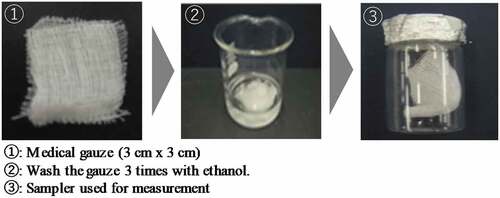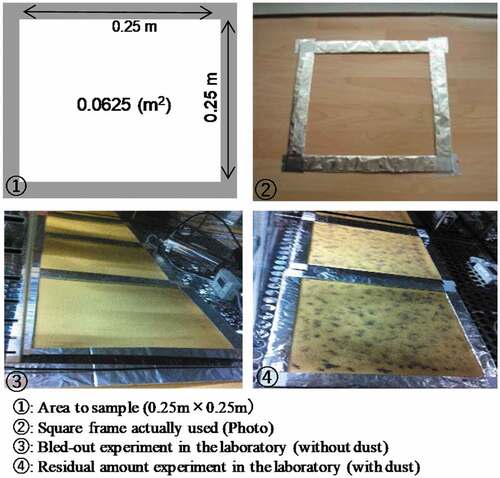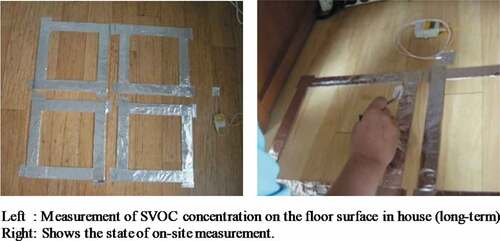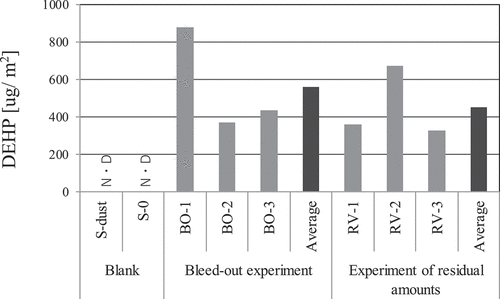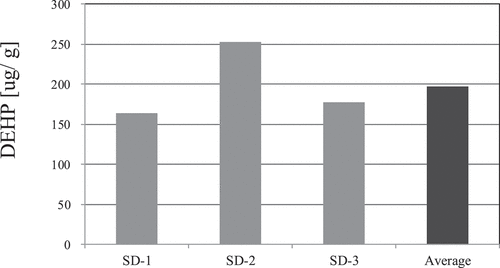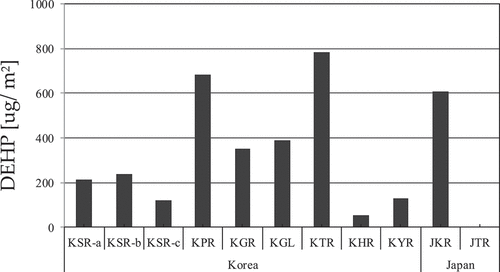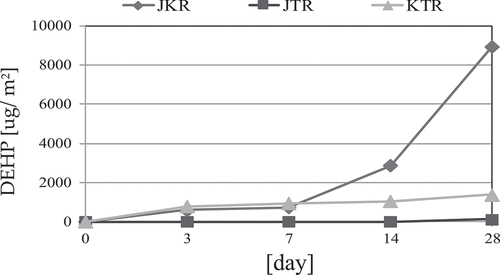ABSTRACT
This study conducted laboratory tests and field surveys to understand the plasticizer contamination characteristics on the surface of PVC flooring materials used indoors, and discussed the risk of exposure of plasticizers to infants indoors. A lab experiment was conducted to measure the bleed-out of DEHP on PVC sheet surfaces. As a result of the bleed-out, the amount of DEHP on the specimen surfaces was 432 to 880 [ug/m2]. The present study showed that plasticizers such as DEHP contained in the PVC sheet accumulate a significant amount of DEHP on the surface of the PVC sheet even if a material such as house dust is not present on the surface of the PVC sheet. In addition, this study found that even if the dust accumulated on the PVC floor surface was vacuumed, it was difficult to completely remove the DEHP accumulated on the floor surface. The field surveys showed that the average concentration of DEHP on the floor surface in Korean and Japanese house were 356 and 608 ug/m2 respectively. Since infants have behavioral characteristics of crawling, sitting, and lying on the floor, they have more opportunities to directly contact the floor than adults.
1. Introduction
Maintaining clean, fresh air indoors is critical for the health of individuals inside buildings (Folinsbee Citation1993; Clayton et al. Citation1993). Volatile organic compounds (VOCs) and semi-volatile organic compounds (SVOCs) respectively are emitted from various household electronic appliances used indoors, building or decoration materials, and a range of household items as well. These substances contribute to the deterioration of indoor living environment quality (Weschler and Nazaroff Citation2008; Weschler Citation2009; Liu, Ye, and Little Citation2013).
Examples of VOCs that pollute indoor environment include substances such as formaldehyde, acetaldehyde, benzene, toluene, styrene, and ethylbenzene. These substances are contained in large quantities in building and decoration materials: paints, wood, adhesives, floor waxes, carpets, textiles, wallpapers, and vinyl flooring. In cases where individuals working or living indoors are exposed to such toxic chemical substances for short or longer term, they can experience sore eyes, irritations in the respiratory system and skin, asthmatic symptoms, headaches, etc. (Billionnet et al. Citation2011; Bluyssen et al. Citation1996; Wolkoff and Nielsen Citation2001; Molhave Citation1989; Missia et al. Citation2010).
Given the aforementioned facts, the World Health Organization (WHO) has provided guidelines for harmful chemicals used indoors (World Health Organisation (WHO) Citation1989, Citation1999). In Korea and Japan, recommendations have been made to use building materials that emit less harmful chemicals to maintain good indoor air quality. Also, it has been made mandatory to provide mechanical ventilation systems in buildings or structures so that specified levels of clean, fresh air can be secured at all times (MHLW Japan, Citation2002; MLIT Japan, Citation2003; Ministry of environment Korea, Citation2004).
SVOCs in particular have been found in large quantities not only in indoor air but in house dust as well. According to reports, SVOC substances found in house dust at ordinary houses are composed mostly of phthalates used as a plasticizer, e.g., DEHP, DnBP, DEP, DOA, DINP, and DIDP (Wensing, Uhde, and Salthammer Citation2005; Bonvallot et al. Citation2010; Bornehag et al. Citation2004; Bergh et al. Citation2010; Abb et al. Citation2009; Larsson et al. Citation2010). The investigations of the present researchers over the past years also revealed that DEHP and DBP among other phthalate substances found in house dust contained higher concentration levels of contaminants and were detected more frequently than other substances (Kim, Tanabe, and Okada Citation2010a). Recently, reports have been written about exposure of certain phthalate esters that are allegedly associated with developmental disorders in male reproductive organs, increased fetal mortality rates, decreased fetal growth and birth weight, and abnormality in intestines and external physique. Additionally, there have been studies on the relationship between the concentration level of phthalates contained in house dust and asthma and allergies found in children (Ritter and Arbuckle Citation2007; Jaakkola and Knight Citation2008; McKee et al. Citation2004; Heudorf, Mersch-Sundermann, and Angerer Citation2007; Latini, De Felice, and Verrotti Citation2004; Matsumoto, Hirata-Koizumi, and Ema Citation2008)
The exposure route of phthalates in individuals living or working indoors is classified roughly into (a) oral ingestion; (b) inhalation; and (c) dermal absorption (NTP-CERHR Citation2006). Children in particular have been found to take in various food items, including breast milk and formula, and phthalates contained therein. Children are being reported to absorb a considerable amount of DEHP especially through house dust intake (Fromme et al. Citation2011; Koch, Drexler, and Angerer Citation2002, Citation2004; Latini et al. Citation2009). A study has found that children inhale house dust 10 times as much as their adult counterparts (Wensing, Uhde, and Salthammer Citation2005), and several researchers have compared the amount of DEHP inhaled by children through house dust with the reference dose suggested by the U.S. EPA, i.e., Rfd: 20ug/kg/day (Wensing, Uhde, and Salthammer Citation2005; John et al. Citation2008). The present researchers also used the same method to calculate DEHP intake of children through house dust, and the results have revealed the majority of households surveyed exceeding the Rfd of 20ug/kg/day (Kim, Tanabe, and Okada Citation2010a). In particular, infants under the age of 3 have behavioral characteristics of crawling, sitting, and lying on the floor, and these behaviors have many opportunities to come into contact with the floor surface. Therefore, it is predicted that the concentration of plasticizers on the floor surface could cause exposure of many plasticizers to infants. Considering this, the present study conducted laboratory experiments and field investigations to find out the DEHP contamination characteristics on the surface of PVC sheets and discussed the risk of plasticizer exposure of infants indoors.
2. Method
2.1. Preparation of sampler
To measure the concentration of DEHP on the PVC sheet surfaces, medical gauze was used. The gauze used as the sampler was 100% cotton, which did not contain DEHP. The medical gauze was washed in ethanol at least 3 times, and then kept it in 20 ml glass vial. A travel blank of sampler was checked for contamination of the sampler during the measurement period. Before the measurement, the contamination of the sampler was confirmed. During each measurement, the travel blank of the sampler was confirmed. The samplers were prepared either immediately before or a day before the actual measurement. Once the samplers were prepared, they were not kept for more than seven days. shows the sampler production process.
2.2. Laboratory experiments
Two types of lab experiments were conducted. The first experiment was the bleed-out of DEHP on PVC flooring surfaces. The purpose was to verify whether or not DEHP, emitted from inside the specimens, can be accumulated on the surface of the specimens even if there was no dust or other substances on the surface of the specimens. The second experiment regards the residual amount of DEHP on the surface of the specimens. For this experiment, imitation dust was sprayed upon the surface of the test specimens, and 3 days later, the imitation dust was collected using a vacuum cleaner. Then, a sampler made of medical gauze was used to measure the concentration of DEHP remaining on the surface of the specimen.
For each experiment, three specimens were used and a total of six specimens were produced. Specimens size was 0.25 m × 0.25 m (0.0625 m2). Before the experiment, the surface of the specimens was wiped off at least three times with a gauze sampler soaked in ethanol so that the surface was free of any contaminants such as dust and other chemicals. To know the initial concentration of the specimen’s surface, we measured the DEHP concentration of the specimen’s surface using a sampler at the same time as the start of the experiment. After sampling the initial DEHP concentration from the specimen surfaces, three of the six specimens were left in a constant temperature and humidity chamber to measure the bleed-out concentration of DEHP on the surface of the specimens. The bleed-out experiment was carried out after 72 hours, and then, the three specimens were subjected to the sampling procedure involving wiping off the specimen surfaces using the sampler. As for the remaining three specimens, the 1.5 g of imitation dust was spread on their surfaces, and then the specimens were left inside the constant temperature and humidity chamber for 72 hours. After that, the imitation dust was collected using a vacuum cleaner. See Reference (Kim, Tanabe, and Okada Citation2010a) for the details of this collection nozzle. Chemicals present in imitation dust was quantitatively and qualitatively analyzed by GC/MS. The detailed condition of GC/MS was shown in .
Table 1. Overview of the lab experiment.
Table 2. Overview of houses subject to measurement.
Table 3. Condition of GC/MS.
After collecting the simulated dust, the DEHP concentration remaining on the surface of the specimens were measured. The measurement method was the same as the measurement method of bleed-out, and the sampler used was the same. For the imitation dust, silica sand as specified by Japanese Industrial Standard (JIS) G 5901 was used of which the particle size was less than 600 μm. Before the experiment, the imitation dust was subjected to heating in a 250 °C oven for 1 hour as pre-treatment. The blank value of the imitation dust was confirmed. The amount of imitation dust was determined to be at a level enough to cover the surface of the specimens and was defined as having no statistically significant meaning. The two lab experiments were conducted inside a constant temperature and humidity chamber, with testing conditions being 28 °C, relative humidity of 50%RH. The PVC flooring used in the experiments was purchased in Korea. DEHP content in the PVC sheet was approximately between 25 and 30%. shows an overview of the lab experiments. shows the state of the laboratory experiment.
2.3. Measurement of DEHP concentration on the surface of household flooring
The subjects (houses) used for measurement were six Korean and two Japanese houses. To measure the concentration of DEHP on flooring surfaces in houses, the sampler used was the same as the one used the lab experiment. The sample area was 0.0625 m2 (0.25 m × 0.25 m), the same as used for the lab experiments. To indicate the location of the floor being measured, we made a square frame with a material that does not contain the chemical to be measured. In the indoor environment, measurement of DEHP concentration on the flooring surfaces was implemented as follows: (a) portions of the flooring to be subject to measurement were determined and were then wiped clean with ethanol-dipped gauze; (b) the square frame was placed upon the portions of flooring determined for measurement, and the areas were measured for the initial concentration of DEHP from the surface; and (c) lastly, after 72 hours, both dust accumulated on the floor surface and bleed-out DEHP were measured. The sampler used at this time was the same as the one used in the lab experiment. In the case of House KS, three square frames were placed inside the same room, hence sampler was named “KSR-a,” “KSR-b” and “KSR-c,” respectively. For two out of the three square frames, flooring surfaces were sampled along with the accumulated dust thereupon. For the remaining square frame (KSR-c), the accumulated dust was removed by using a vacuum cleaner, followed by a sampling of the floor surfaces. House KG was measured at the room and the living room for the concentration of DEHP on the flooring surface. In the case of KT houses in Korea, JK and JT houses in Japan, four square frames were placed in the same place to measure changes in DEHP concentration on the flooring surface over time. The sampling was conducted to be initial concentration and 3, 7, 14, and 28 days. During the measurement period, occupants were asked not to step on or clean the surface to be measured. demonstrates an overview of the houses subject to measurement. shows the measurement of SVOC concentration on the floor surface in a general house.
2.4. Method of analysis
The imitation dust and sampler were placed in a centrifugal tube; 5 ml of dichloromethane was injected into the sampler or imitation dust; and then ultrasonic waves were used to perform solvent extraction for 30 minutes. Afterward, a syringe filter unit (GL Science: Liquid chro disk (13C)) was used to filter sampler made of gauze. Qualitative and quantitative analyses were conducted using a GC/MS. This study used the absolute calibration curve method for the analysis of DEHP. The standard solution of DEHP (100 mg/L) was diluted with dichloromethane, and the range of the absolute calibration curve was 0, 5, 10, 20, 50, 100 µg/ml. The correlation coefficient (R2) between the peak area and the concentration was 0.998 or more. The concentration of detection limit was 5 µg or less. The analysis of DEHP concentration of imitation dust and sampler is the same as that of SVOC concentration of house dust, and information on the chemical analysis method was referenced in Hyuntae Kim, Tanabe, and Okada Citation2010(a). summarizes GC/MS conditions.
3. Results
3.1. Lab experiment
3.1.1. Surface bleed-out and the residual amount
indicates the lab experiment results. The blank value of the imitation dust and the initial DEHP concentration of specimen surfaces were found to be below the detection limit (<5 ug). The results of the bleed-out experiment show that the amount of DEHP on the specimen surfaces was 432 to 880 [ug/m2], with the average amount being 560 [ug/m2]. The amount of DEHP present on the surface of the specimen subject to measurement following vacuum-cleaning of the imitation dust was between 320 and 672 [ug/m2], with 448 [ug/m2] being the average amount. When comparing the amount of bleed-out DEHP on the surface of the specimen and the amount of DEHP on the specimen after cleaning, the amount of DEHP after cleaning was reduced by 25%, compared to the amount of bleed-out DEHP. The lab experiment in this study confirmed that the bleed-out phenomenon does occur on the surface of PVC flooring. Furthermore, this study verified that the removal of imitation dust using vacuum cleaning could not completely remove the DEHP remaining on the surface of specimens.
3.1.2. DEHP concentrations in imitation dust
shows the concentrations of DEHP contained in the imitation dust collected; and they indicate the values converted to per-gram DEHP concentrations. Initially, the amount of imitation dust sprayed on the specimens was 1.5 grams, and the amount of imitation dust collected in the cleaning is as follows. The amounts of the collected imitation dust (recovery rates [%]) were 1.16 [g] (77.3%), 1.43 [g] (95.3%), and 1.24 [g] (82.7%) respectively. The amount of DEHP contained in the imitation dust was 164 to 252[ug/g]. In addition, the average amount of DEHP contained in the imitation dust was 198[ug/g]. Through this laboratory experiment, the study confirmed that PVC building materials containing plasticizers are surface bleed-out and that a large amount of DEHP remains even when dust deposited on the floor is removed using a vacuum cleaner.
3.2. The concentration of DEHP on flooring surfaces in houses
3.2.1. DEHP concentration from short-term measurement (3 Days)
shows the concentration of DEHP on flooring surfaces. Inside the room of House KS, 3 square frames were placed, i.e., KSR-a, KSR-b, and KSR-c. For KSR-a and KSR-b, DEHP concentration was measured by wiping off flooring surfaces, along with the accumulated dust thereupon. Consequently, DEHP concentrations were 208 and 240 [ug/m2] respectively. The average concentration of DEHP on flooring surfaces was 224[ug/m2]. For KSR-c, where the accumulated dust was vacuum-cleaned before measurements were taken, the concentration of the flooring surfaces per m2 was measured to be 128 [ug/m2], with a considerable amount of DEHP confirmed to be still present. Even if the dust accumulated on the floor surface was removed using a vacuum cleaner, the concentration of DEHP removed by the vacuum cleaner was 43%. These results were similar to the trends found in the Lab experiment. All houses measured in Korea used PVC sheets as the flooring material, but the DEHP concentration on the floor surface was measured differently. The DEHP concentration of the floor surfaces was from 53 to 784 [ug/m2], and among these, the highest measured house was the KT house. The average concentration of DEHP on the floor surface was 356 [ug/m2]. In the case of JKR of a Japanese house, the DEHP concentration of the floor surface was measured to be 608 [ug/m2], and this house also used a PVC sheet as a flooring material. However, the DEHP concentration of the floor surface of the JTR house was measured to be below the detection limit, and this house used wooden flooring. This study found that the DEHP concentration of the floor surface was measured differently, depending on the floor materials.
3.2.2. Changes in DEHP concentration obtained from long-term measurement (0 to 28 Days)
shows the DEHP concentration of the floor surface over time. Houses measured over the long term are KT (Korea), JK, and JH (Japan). In each room of the mentioned houses, four square frames were placed to measure DEHP concentrations on days 0 (initial concentration), 3rd, 7th, 14th, and 28th, when DEHP was accumulated on the floor surface. Here, the initial concentration is the DEHP concentration measured after removing the accumulated dust and adsorbed DEHP on the floor surface. Initial DEHP concentrations in all houses were measured below the detection limit. The flooring material for the Korean house KT and the Japanese house JK was used PVC sheets; and the JT flooring material in the Japanese house was wooden flooring. In the case of JKR and KTR using PVC flooring, the concentration of DEHP accumulated on the floor surface for 3 days was 615 and 784 ug/m2 and the floor concentration of DEHP accumulated for 7 days was 735 and 944 ug/m2, respectively. However, the DEHP concentration on the floor surface for 14 days shows a significant difference. In the case of JK house, the DEHP concentration of the floor surface for 14 days was 2880 ug/m2, and in the KT house, the DEHP concentration of the floor surface for 14 days was 1056 ug/m2. The DEHP concentration of the floor surface of JK house was measured 2.7 times higher than that of KT house. In addition, the DEHP floor concentration of JK house for 28 days was measured 6.4 times higher than that of KT house. This study found that even if PVC sheets were used as the floor material, the DEHP concentration of the floor surface could be changed by the indoor physical environment such as temperature, humidity, and the amount of dust deposited. In addition, by cleaning the floor once a day or every 3 days, the concentration of DEHP accumulated on the floor could be reduced. On the other hand, in the case of JT houses where wooden material was used for the floor, the concentration of DEHP accumulated on the floor for 14 days was below the detection limit (<3ug); and the DEHP concentration of the floor surface for 28 days was 146 ug/m2. According to the results of this measurement, it can be seen that the DEHP concentration of the floor surface is closely related to the type of floor material.
4. Discussion
Phthalates are used as a plasticizer to enhance the ductility and productivity of plastic products (Latini, De Felice, and Verrotti Citation2004). Examples of phthalates used for those purposes include dibutyl phthalate (DBP), di-isononyl phthalate (DINP), benzyl butyl phthalate (BBP), di-isodecyl phthalate (DIDP), and di (2-ethylhexyl) phthalate. In particular, DEHP is used frequently in the manufacturing of building materials such as vinyl-flooring and vinyl-wall covering; and the content of DEHP is approximately 15–40 % (w/w) (Clausen et al. Citation2004; Bornehag et al. Citation2005; Fromme et al. Citation2004). Korean houses often use PVC as a flooring material. According to a study carried out by Kim, Tanabe, and Okada (Citation2010a); Kim et al. (Citation2010b), the concentration of DEHP in house dust found in Korean houses was considerably higher than those of other countries. Furthermore, the level of DEHP exposure to Korean children through house dust intake was expected to be extremely high.
Phthalates contaminating indoor environments could pose bigger risks to children than to adults. DEHP exposure routes for individuals living or working indoors include inhalation, dermal absorption, and oral ingestion of house dust, and risks thereof are evaluated accordingly (Wensing, Uhde, and Salthammer Citation2005; John et al. Citation2008). Xu et al. (Citation2009) reported that 0.6 ug/kg/day of DEHP was inhaled on average; and the amount of DEHP absorbed through the skin was larger than the amount inhaled through breathing. Furthermore, the study also reported that the amount of DEHP orally ingested in the form of house dust was 1.6 times that of what the U.S. EPA has specified in its reference dose (Rfd: 20 ug/kg/day). Similar findings were also reported by other studies (Wensing, Uhde, and Salthammer Citation2005; Fromme et al. Citation2007). Lab experiment results found in this study also confirmed that the concentration of DEHP contained in mock-up dust was considerably larger than the concentration of DEHP on the surfaces of test specimens. As attested by many studies, the principal form of DEHP exposure route in children is oral ingestion of dust accumulated on flooring surfaces. However, Weschler and Nazaroff (Citation2012) pointed out that the effects of dermal absorption of SVOCs present indoors could be much bigger than those of inhalation and oral ingestion of house dust. Based on the results of this study, it is expected that the country’s lifestyle habits and children’s behavioral characteristics will be related to the DEHP concentration of the floor surface and the risk assessment.
In the case of PVC flooring containing DEHP, it was confirmed that even without substances such as house dust to the surface of test specimens, DEHP bleeds out to the surface of building materials. The study also found that removal of the accumulated dust by vacuum cleaning could reduce the amount of DEHP contamination in flooring surfaces. Nevertheless, it is considered impossible to completely remove DEHP accumulated on the flooring surfaces. However, infants have generally more opportunities to contact the flooring through sitting, crawling, and lying down on the flooring. During summer, in particular, their bare arms and legs are in direct contact with the flooring where their chance of being exposed to high DEHP concentrations increases. This is expected to be considerably higher than that of being exposed to DEHP contained in the air (gas phase; airborne dust). Hence, SVOCs exposure through skin routes should not be underestimated.
As reported by Xue et al. (Citation2007), frequency of infants’ hand-to-mouth activity is extremely important in evaluating exposure routes. Infants could ingest plasticizers by licking their hands in direct contact with the PVC flooring, so frequent cleaning may be helpful to reduce the amount of plasticizers intake by infants’ behaviors. It has been reported that the cleaning frequency is usually cleaned once every 3 or 7 days in Korea and Japan. According to the long-term change in the DEHP concentration on the floor surface in this study (), the change in the DEHP concentration on the floor surface between 3 and 7 days was small. If the flooring material is PVC flooring, it was expected that cleaning within a week could keep the DEHP concentration low on the floor surface. However, it is necessary to discuss whether or not infants’ exposure to plasticizers has decreased due to the cleaning of the floor.
The results of DEHP concentration on flooring surfaces in Korean and Japanese houses were found similar to the results obtained from the lab tests. After removing the accumulated dust using a household vacuum cleaner, a significant amount of DEHP was detected as a result of measuring the concentration of DEHP remaining on the floor surface. Therefore, it has been confirmed that simply removing dust could not keep the floor clean. These results show the reasons why many discussions are needed on the effects of cleaning frequency and plasticizer concentration on the floor surface on infants’ health. In addition, it is worth noting through this study that even though all measured houses used PVC sheets as a flooring material, the concentration of DEHP detected on the floor surface of each house was quite different (). Such results are assumed to be affected by the physical environment, including room temperature and relative humidity, amount of dust accumulated, year of building completion, and the amount of DEHP contained in each flooring material.
5. Conclusions
This study measured the amount of bleed-out of DEHP contained in PVC flooring through laboratory experiments and the amount of change in DEHP concentration on the floor surface through the actual survey. As a result of this study, we discussed the need to approach the subject of children’s exposure to DEHP concerning PVC flooring used in indoor environments. Additionally, this study proposed solutions to reduce the concentration of DEHP present on the surfaces of indoor flooring. This study also implies that there are more probabilities for children to have a direct contact with building materials used in indoor flooring, unlike ceiling and walls. In particular, the flooring materials included DEHP can be accumulated high concentrations on the surface of floor due to bleed-out. Also, this study confirmed that eliminating all DEHP accumulated on the flooring is nearly impossible even if the accumulated house dust was vacuum-cleaned. Frequent cleaning could surely help reduce the amount of house dust ingested, inhaled, or absorbed by children. Nevertheless, investigation with greater depth will be necessary to enable the evaluation of children’s exposure to DEHP with their behavioral characteristics such as crawling and lying down on indoor flooring and licking their fingers.
Acknowledgments
This research was supported by Ministry of Health, Labor and Welfare, KAKENHI Grant Number (21KD2002) and JSPS KAKENHI Grant Number (20K04809)
References
- Abb, M., T. Heinrich, E. Sorkau, and W. Lorenz. 2009. “Phthalates in House Dust.” Environment International 35 (6): 965–970. doi:10.1016/j.envint.2009.04.007.
- Bergh, C., R. Torgrip, G. Emenius, and C. Ostman. 2010. “Organophosphate and Phthalate Esters in Air and Settled Dust – A Multi-location Indoor Study.” Indoor Air 21 (1): 67–76. doi:10.1111/j.1600-0668.2010.00684.x.
- Billionnet, C., E. Gay, S. Kirchner, B. Leynaert, and I. Annesi Maesano. 2011. “Quantitative Assessments of Indoor Air Pollution and Respiratory Health in a Population Based Sample of French Dwellings.” Environmental Research 111 (3): 225–434. doi:10.1016/j.envres.2011.02.008.
- Bluyssen, P. M., E. De Oliveira Fernandes, L. Groes, G. Clausen, P. O. Fanger, O. Valbjorn, C. A. Bernhard, and C. A. Roulet. 1996. “Europenan Indoor Air Quality Audit Project in 56 Office Buildings.” Indoor Air 6 (4): 221–238. doi:10.1111/j.1600-0668.1996.00002.x.
- Bonvallot, N., C. Mandin, F. Mercier, B. Le Bot, and P. Glorennec. 2010. “Health Ranking of Ingested Semi-volatile Organic Compounds in House Dust.” Indoor Air 20 (6): 458–472. doi:10.1111/j.1600-0668.2010.00667.x.
- Bornehag, C. G., B. Lundgren, C. J. Weschler, T. Sigsgaard, L. Hagerhed-Engman, and J. Sundell. 2005. “Phthalates in Indoor Dust and Their Association with Building Characteristics.” Environmental Health Perspectives 113 (10): 1399–1404. doi:10.1289/ehp.7809.
- Bornehag, C., J. Sundell, C. J. Weschler, T. Sigsgaard, B. Lundgren, M. Hasselgren, and L. Hägerhed-Engman. 2004. “The Association between Asthma and Allergic Symptoms in Children and Phtalates in House Dust: A Nested Case-Control Study.” Environmental Health Perspectives 112 (14): 1393–1397. doi:10.1289/ehp.7187.
- Clausen, P. A., V. Hansen, L. Gunnarsen, A. Afshari, and P. Wolkoff. 2004. “Emission of Di-2-ethylhexyl Phthalate from PVC Flooring into Air and Uptake in Dust: Emission and Sorption Experiments in FLEC and CLIMPAQ.” Environmental Science & Technology 38 (9): 2531–2537. doi:10.1021/es0347944.
- Clayton, C. A., R. L. Perrit, E. D. Pellizzari, K. W. Thomas, R. W. Whitmore, L. A. Wallace, H. Ozkayna, and J. D. Spengler. 1993. “Particle Total Exposure Assessment Methodology (PTEAM) Study: Distributions of Aerosol and Elemental Concentrations in Personal, Indoor and Outdoor Air Samples in a Southern California Community.” Journal of Exposure Analysis and Environmental Epidemiology 3 (2): 227–250.
- Folinsbee, L. J. 1993. “Human Health Effects of Air Pollution.” Environmental Health Perspectives 100: 45–56. doi:10.1289/ehp.9310045.
- Fromme, H., L. Gruber, M. Schlummer, G. Wolz, S. Bohmer, J. Angerer, R. Mayerd, B. Liebld, and G. Bolte. 2007. “Intake of Phthalates and Di(2-ehthylhexyl(adipate): Results of the Integrated Exposure Assessment Survey Based on Duplicate Diet Samples and Biomonitoring Data.” Environment International 33 (8): 1012–1020. doi:10.1016/j.envint.2007.05.006.
- Fromme, H., L. Gruber, E. Seckin, U. Raab, S. Zimmermann, M. Kiranoglu, M. Schlummer, U. Schwegler, S. Smolic, and W. Volkel for the HBMnet. 2011. “Phthalates and Their Metabolites in Breast Milk –results from the Bavarian Monitoring of Breast Milk (BAMBI).” Environment International 37 (4): 715–722. doi:10.1016/j.envint.2011.02.008.
- Fromme, H., T. Lahrz, M. Piloty, H. Gebhart, A. Oddoy, and H. Ruden. 2004. “Occurrence of Phthalates and Musk Fragrances in Indoor Air and Dust from Apartments and Kindergartens in Berlin (Germany).” Indoor Air 14 (3): 188–195. doi:10.1111/j.1600-0668.2004.00223.x.
- Heudorf, U., V. Mersch-Sundermann, and J. Angerer. 2007. “Phthalates: Toxicology and Exposure.” International Journal of Hygiene and Environmental Health 210 (5): 623–634. doi:10.1016/j.ijheh.2007.07.011.
- Jaakkola, J. J. K., and T. L. Knight. 2008. “The Role of Exposure to Phthalates from Polyvinyl Chloride Products in the Development of Asthma and Allergies: A Systematic Review and Meta-analysis.” Environmental Health Perspectives 116 (7): 845. doi:10.1289/ehp.10846.
- John, C. L., X. Ying, E. Cohen Hubal, and P. A. Clausen. 2008. “Exposure to Phthalate Emitted from Vinyl Flooring and Sorbed to Interior Surfaces, Dust, Airborne Particles and Human Skin.” Proceeding of Indoor Air 2008 11–22. Copenhagen, Denmark.
- Kim, H.-T., S.-I. Tanabe, and K. Okada. 2010a. “Measurement of DEHP Concentration in House in Japan and Korea, Architectural Institute of Japan.” Journal of Environmental Engineering (Transactions of AIJ) 75 (654): 713–720. doi:10.3130/aije.75.713.
- Kim, H.-T., S.-I. Ttanabe, T.-W. Kim, and W.-H. Hong. 2010b. “Measurement of Phthalate Esters Concentration in House Dust in Residence of Daegu.” Architectural Institute of Korea 26: 313–320.
- Koch, H. M., H. Drexler, and J. Angerer. 2002. “An Estimation of the Daily Intake of Di(2-ethylhexyl) Phthalate (DEHP) and Other Phthalates in the General Population.” International Journal of Hygiene and Environmental Health 206 (2): 77–83. doi:10.1078/1438-4639-00205.
- Koch, H. M., H. Drexler, and J. Angerer. 2004. “Internal Exposure of Nursery-school Children and Their Parents and Teachers to Di(2-ethylhexyl) Phthalate (DEHP.” International Journal of Hygiene and Environmental Health 207 (1): 15–22. doi:10.1078/1438-4639-00270.
- Larsson, M., L. Hagerhed-Engman, B. Kolarik, P. James, F. Lundin, S. Janson, J. Sundell, and C. G. Bornehag. 2010. “PVC-as Flooring Material- and Its Association with Incident Asthma in a Swedish Child Cohort Study.” Indoor Air 20 (6): 494–501. doi:10.1111/j.1600-0668.2010.00671.x.
- Latini, G., C. De Felice, and A. Verrotti. 2004. “Plasticizers, Infant Nutrition and Reproductive Health.” Reproductive Toxicology 19 (1): 27–33. doi:10.1016/j.reprotox.2004.05.011.
- Latini, G., M. Wittassek, A. D. Vecchio, G. Presta, C. De Felice, and J. Angerer. 2009. “Lactational Exposure to Phthalates in Southern Italy.” Environment International 35 (2): 236–239. doi:10.1016/j.envint.2008.06.002.
- Liu, Z., W. Ye, and J. C. Little. 2013. “Predicting Emissions of Volatile and Semi-volatile Organic Compounds from Building Materials: A Review.” Building and Environment 64: 7–25. doi:10.1016/j.buildenv.2013.02.012.
- Matsumoto, M., M. Hirata-Koizumi, and M. Ema. 2008. “Potential Adverse Effects of Phthalic Acid Esters on Human Health: A Review of Recent Studies on Reproduction.” Regulatory Toxicology and Pharmacology 50 (1): 37–49. doi:10.1016/j.yrtph.2007.09.004.
- McKee, R. H., J. H. Butala, R. M. David, and G. Gans. 2004. “NTP Center for the Evaluation of Risks to Human Reproduction Reports on Phthalates: Addressing the Data Gaps.” Reproductive Toxicology 18 (1): 1–22. doi:10.1016/j.reprotox.2003.09.002.
- MHLW: Ministry of health, Labour and Welfare. Japan. 2002 Progress Report on Sick Building Syndrome -The Summary of 8th and 9th Investigative Commission. Assessed 30 May 2018. http://www.mhlw.go.jp/houdou/2002/02/h0208-3.html
- Ministry of environment. Korea. Assessed 20 June 2018. http://www.law.go.kr/LSW/lsInfoP.do?lsiSeq=133341#AJAX
- Missia, D. A., E. Demetriou, N. Michael, E. I. Tolis, and J. G. Bartzis. 2010. “Indoor Exposure from Building Materials: A Field Study.” Atmospheric Environment 44 (35): 4388–4495. doi:10.1016/j.atmosenv.2010.07.049.
- MLIT: Ministry of Land, Infrastructure and Transport. 2003. Japan. Assessed 14 May 2018. http://www.mlit.go.jp/jutakukentiku/sikuhouse.html
- Molhave, L. 1989. “The Sick Buildings and Other Buildings with Indoor Climate Problems.” Environment International 15 (1–6): 65–74. doi:10.1016/0160-4120(89)90011-1.
- NTP-CERHR. 2006. Monograph on the Potential Human Reproductive and Developmental Effects of Di (2-Ethylhexyl) Phthalate (DEHP), U.S.A.: Assessed 12 July 2013. http://ntp.niehs.nih.gov/ntp/ohat/phthalates/dehp/DEHP-Monograph.pdf
- Ritter, L., and T. E. Arbuckle. 2007. “Can Exposure Characterization Explain Concurrence or Discordance between Toxicology and Epidemiology?” Toxicological Sciences 97 (2): 241–252. doi:10.1093/toxsci/kfm005.
- Wensing, M., E. Uhde, and T. Salthammer. 2005. “Plastics Additives in the Indoor Environment—flame Retardants and Plasticizers.” Science of the Total Environment 339 (1–3): 19–40. doi:10.1016/j.scitotenv.2004.10.028.
- Weschler, C. J. 2009. “Changes in Indoor Pollutants since the 1950s.” Atmospheric Environment 43 (1): 153–169. doi:10.1016/j.atmosenv.2008.09.044.
- Weschler, C. J., and W. W. Nazaroff. 2008. “Semivolatile Organic Compounds in Indoor Environments.” Atmospheric Environment 42 (40): 9018–9040. doi:10.1016/j.atmosenv.2008.09.052.
- Weschler, C. J., and W. W. Nazaroff. 2012. “Review Article SVOC Exposure Indoors: Fresh Look at Dermal Pathways.” Indoor Air 22 (5): 356–377. doi:10.1111/j.1600-0668.2012.00772.x.
- Wolkoff, P., and G. D. Nielsen. 2001. “Organic Compounds in Indoor Air – Their Relevance for Perceived Indoor Air Quality?” Atmospheric Environment 35 (26): 4407–4417. doi:10.1016/S1352-2310(01)00244-8.
- World Health Organisation (WHO). 1989. “Indoor Air Quality: Organic Pollutants.” Reports on a WHO –Meetings, Copenhagen, Denmark, WHO Regional office for Europe (Euro Reports and studies 111)
- World Health Organization (WHO). 1999. Guidelines for Air Quality. Geneva: WHO.
- Xu, Y., E. A. Cohen Hubal, P. A. Clausen, and J. C. Little. 2009. “Predicting Residential Exposure to Phthalate Plasticizer Emitted from Vinyl Flooring: A Mechanistic Analysis.” Environmental Science & Technology 43 (7): 2374–2380. doi:10.1021/es801354f.
- Xue, J., V. Zartarian, J. Moya, N. Freeman, P. Beamer, K. Black, N. Tulve, and S. Shalat. 2007. “A Meta-analysis of Children`s Hand-to Mouth Frequency Date for Estimating Nondietary Ingestion Exposure, Risk Anal.” Risk Analysis: An Official Publication of the Society for Risk Analysis 27 (2): 411–420. doi:10.1111/j.1539-6924.2007.00893.x.

